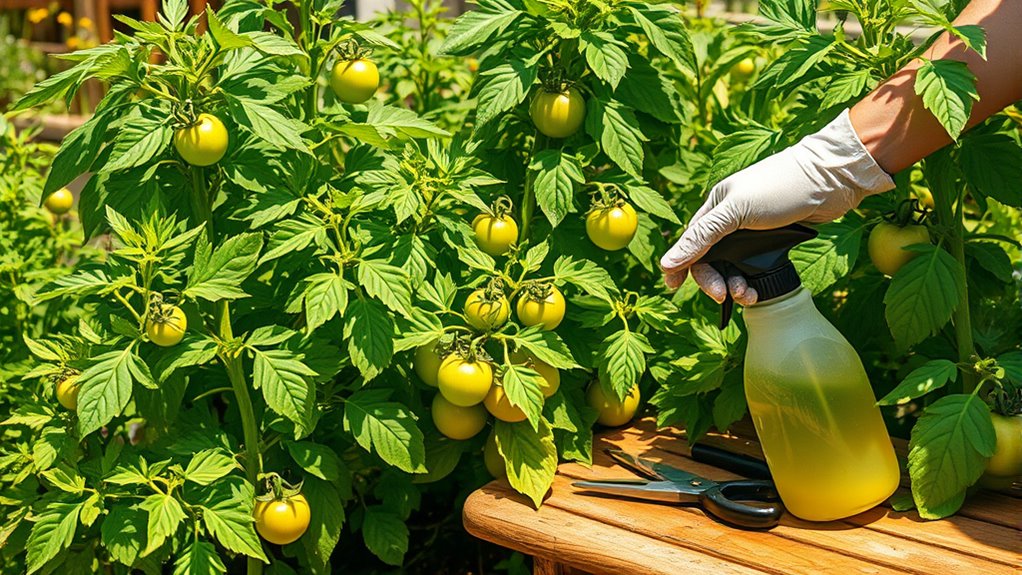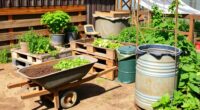To prevent and treat common garden diseases, focus on proper composting to boost soil health and avoid spreading pathogens. Monitor plants regularly for early signs of trouble, and use resistant varieties to reduce vulnerability. Keep your garden clean by removing debris, weeds, and infected material, and practice good watering habits to prevent fungal issues. Incorporate integrated pest management to control insects that spread disease. Learn more tips to keep your garden healthy and disease-free.
Key Takeaways
- Practice proper composting to promote soil health and reduce disease-causing pathogens.
- Regularly inspect plants for early signs of disease and apply organic treatments promptly.
- Use disease-resistant plant varieties and maintain healthy soil to boost plant immunity.
- Manage watering carefully, avoiding excess moisture and removing debris to prevent fungal growth.
- Implement integrated pest management to control pests that transmit or exacerbate plant diseases.

Gardens are lush and vibrant, but they can quickly fall prey to diseases that threaten their health. To keep your garden thriving, you need to stay vigilant and implement effective prevention and treatment methods. One of the foundational steps is practicing good compost management. Proper composting helps improve soil health by adding essential nutrients and beneficial microorganisms that strengthen your plants’ natural defenses. Make sure your compost pile is well-aerated, maintains the right moisture level, and heats up sufficiently to kill off disease-causing pathogens. Avoid composting diseased plant material, as this can spread infections back into your garden, undermining your efforts. Instead, focus on creating a balanced compost that promotes healthy microbial activity, which in turn boosts your plants’ resilience.
Alongside compost management, pest control strategies are *essential* in preventing many garden diseases. Pests like aphids, beetles, and mites often carry or cause plant diseases, so managing their populations reduces infection risks. Regularly inspect plants for signs of pests and take immediate action when you spot trouble. Use integrated pest management (IPM) techniques that combine biological controls, such as introducing beneficial insects like ladybugs, with organic sprays or physical barriers. Avoid overusing chemical pesticides, as they can harm helpful insects and disrupt your garden’s balance. Instead, focus on targeted, environmentally friendly methods that keep pests in check without compromising plant health or soil quality. Additionally, understanding disease-resistant plant varieties can be a powerful tool in reducing susceptibility to common infections. Incorporating healthy soil practices can also enhance the overall vigor and disease resistance of your plants.
It’s also *vital* to maintain proper watering practices. Overwatering creates damp conditions that foster fungal diseases, while underwatering stresses plants, making them more susceptible to infections. Water early in the day to allow moisture to evaporate and prevent prolonged wetness on foliage. Mulching around plants can help regulate soil moisture and temperature, which reduces stress and discourages disease development. Additionally, cultivating good garden hygiene by removing fallen leaves, diseased debris, and weeds, which can harbor pathogens. Rotating crops annually can also prevent soil-borne diseases from establishing themselves. Maintaining optimal moisture levels is key to preventing fungal outbreaks and keeping plants healthy.
Finally, staying proactive with regular monitoring is your best defense. Keep an eye out for early signs of disease, such as spots, discoloration, or abnormal growths. When you catch issues early, treatments are more effective, and you can prevent the spread to healthy plants. Using organic fungicides or homemade remedies can often control mild infections, but in severe cases, you might need to remove and dispose of infected plants to protect the rest of your garden. Combining these practices—proper compost management, pest control strategies, and vigilant monitoring—gives you a solid foundation to keep your garden healthy, productive, and disease-free.
Frequently Asked Questions
How Can I Identify Different Garden Diseases Early?
To identify different garden diseases early, focus on disease symptom recognition and plant health monitoring. Regularly inspect your plants for unusual spots, discoloration, or wilting. Look for patterns like leaf lesions or mold growth. By staying attentive and observing changes, you catch issues before they spread. This proactive approach helps you address problems promptly, keeping your garden healthy and thriving. Early detection is key to effective treatment and prevention.
Are There Organic Methods to Treat Fungal Infections?
Think of fungal infections as unwelcome invaders; you can fight back with organic methods. You might use organic fungicides like neem oil or copper sprays, which act like natural shields. Biological controls, such as beneficial fungi or bacteria, serve as allies, outcompeting harmful fungi and restoring balance. These eco-friendly strategies help you protect your garden without resorting to harsh chemicals, keeping your plants healthy and vibrant.
What Soil Conditions Favor Disease Development?
You should know that soil conditions like soil pH imbalance and excessive moisture can promote disease development. When the pH is off, beneficial microbes struggle, allowing pathogens to thrive. Too much water creates a damp environment, perfect for fungi and bacteria to grow. To reduce disease risk, guarantee your soil has proper pH levels and good drainage, maintaining a balanced, healthy environment for your plants.
Can Crop Rotation Prevent Disease Recurrence?
Think of crop rotation like changing a game’s strategy to outsmart your opponent. It can indeed prevent disease recurrence by breaking the cycle of pathogens in your soil. You’ll also want to incorporate companion planting and resistant varieties, which act like shields against diseases. By rotating crops, planting strategically, and choosing resistant plants, you create a resilient garden that’s less prone to recurring problems.
How Do Weather Patterns Influence Disease Outbreaks?
Weather patterns, including weather cycles and humidity levels, play a big role in disease outbreaks. You’ll notice that during high humidity or prolonged wet periods, fungal and bacterial diseases thrive. Warm, humid weather creates ideal conditions for spores to spread and infect plants. By monitoring these patterns, you can anticipate outbreaks and take preventive steps, like adjusting watering or improving air circulation, to keep your garden healthier and reduce disease risks.
Conclusion
By staying vigilant and practicing good garden hygiene, you can easily prevent most common diseases. Don’t think it’s too much effort—many issues are simply avoided with regular watering, proper spacing, and removing sick plants. Even if you’re new to gardening, these simple steps make a big difference. So, keep an eye out for signs of trouble, act quickly, and enjoy a healthy, thriving garden without the frustration of preventable diseases.










